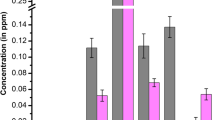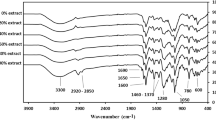Abstract
Yacon (Smallanthus sonchifolius (Poepp.) H. Robinson) leaves is traditionally consumed as herbal tea in many countries including Indonesia. This plant’s antidiabetic properties have been extensively researched, but studies on the responsible active compound identification are scarce. Information on the active compounds is critical for the consistency of Yacon herbal tea quality. The aim of this study was to identify α-glucosidase inhibitors in Indonesian Yacon leaves grown in two different locations using FTIR- and LC–MS/MS-based metabolomics in combination with in silico technique. Yacon leaves ethanol (50 and 95%) and water extracts were tested for α-glucosidase inhibitory activity, with the 95% ethanol extract being the most active. Geographical origins were found to have no major impact on the activity. In parallel, chemical profile of Yacon leaves extract was determined using FTIR and LC–MS/MS. Orthogonal Projection to Latent Structure (OPLS) was used to analyze both sets of data. OPLS analysis of FTIR data showed that compounds associated to α-glucosidase inhibitor activity included those with functional groups –OH, stretched CH, carbonyl, and alkene. It was consistent with the result of OPLS analysis of LC–MS/MS data, which revealed that based on their VIP and Y-related coefficient value, nystose, 1-kestose, luteolin-3′-7-di-O-glucoside, and 1,3-O-dicaffeoilquinic acid isomers, strongly linked to Yacon’s α-glucosidase inhibitor activity. In silico study supported these findings, revealing that the four compounds were potent α-glucosidase inhibitors with docking score in the range of − 100.216 to − 115.657 kcal/mol, which are similar to acarbose (− 115.774 kcal/mol) as a reference drug.
Graphical abstract




Similar content being viewed by others
Data Availability
All data and supplementary information are available as supplementary files and submitted together with the main manuscript.
Code Availability
Not Applicable.
References
Kumar S, Narwal S, Kumar V, Prakash O (2011) α-glucosidase inhibitors from plants: a natural approach to treat diabetes. Pharmacogn Rev 5:19–29. https://doi.org/10.4103/0973-7847.79096
Proença C, Freitas M, Ribeiro D et al (2017) α-glucosidase inhibition by flavonoids: an in vitro and in silico structure–activity relationship study. J Enzyme Inhib Med Chem 32:1216–1228. https://doi.org/10.1080/14756366.2017.1368503
Ojansivu I, Ferreira CL, Salminen S (2011) Yacon, a new source of prebiotic oligosaccharides with a history of safe use. Trends Food Sci Technol 22:40–46. https://doi.org/10.1016/j.tifs.2010.11.005
Valentová K, Ulrichová J (2003) Smallanthus sonchifolius and Lepidium meyenii - prospective Andean crops for the prevention of chronic diseases. Biomed Pap Med Fac Univ Palacky Olomouc Czech Repub 147:119–130. https://doi.org/10.5507/bp.2003.017
Kakuta H, Seki T, Hashidoko Y, Mizutani J (1992) Ent -kaurenic acid and its related compounds from glandular trichome exudate and leaf extracts of Polymnia sonchifolia. Biosci Biotechnol Biochem 56:1562–1564. https://doi.org/10.1271/bbb.56.1562
Genta SB, Cabrera WM, Mercado MI et al (2010) Hypoglycemic activity of leaf organic extracts from Smallanthus sonchifolius: constituents of the most active fractions. Chem Biol Interact 185:143–152. https://doi.org/10.1016/j.cbi.2010.03.004
Zheng X, Fan H, Guo-Kang T et al (2010) Anti-diabetes constituents in leaves of Smallanthus sonchifolius. Nat Prod Commun 5:1–4. https://doi.org/10.1177/1934578X1000500123
Serra-Barcellona C, Habib NC, Honoré SM et al (2017) Enhydrin regulates postprandial hyperglycemia in diabetic rats by inhibition of α-glucosidase activity. Plant Foods Hum Nutr 72:156–160. https://doi.org/10.1007/s11130-017-0600-y
Yuliana ND, Rosa D, Budijanto S et al (2014) Identification of adenosine A1 receptor ligands from Morus alba L. stem bark by NMR metabolomics approach. Int Food Res J 21:1067–1071
Aziz Z, Al Qisthi FH, Yuliana ND, Simanjuntak P (2019) Identification of α-glucosidase enzyme inhibitor compound from ethanol 96% extract of yakon leaves (Smallanthus sonchifolius [Poepp. & Endl.] H. Robinson). J Ilmu Kefarmasian Indones 17:21
Sancheti S, Sancheti S, Seo SY (2009) Chaenomeles sinensis: a potent alpha-and beta-glucosidase inhibitor. Am J Pharmacol Toxicol 4:8–11. https://doi.org/10.3844/ajptsp.2009.8.11
Naylor RL, Battisti DS, Vimont DJ et al (2007) Assessing risks of climate variability and climate change for Indonesian rice agriculture. Proc Natl Acad Sci USA 104:7752–7757. https://doi.org/10.1073/pnas.0701825104
Worley B, Powers R (2016) PCA as a practical indicator of OPLS-DA model reliability. Curr Metabolomics 4:97–103. https://doi.org/10.2174/2213235X04666160613122429
Eriksson L, Trygg J, Wold S (2008) CV-ANOVA for significance testing of PLS and OPLS® models. J Chemom 22:594–600. https://doi.org/10.1002/cem.1187
Lindgren F, Hansen B, Karcher W (1996) Model validation by permutation tests. J Chemom 10:521–532. https://doi.org/10.1002/(SICI)1099-128X(199609)10:5/6%3C521::AID-CEM448%3E3.0.CO;2-J
Habib NC, Honoré SM, Genta SB, Sánchez SS (2011) Hypolipidemic effect of Smallanthus sonchifolius (yacon) roots on diabetic rats: biochemical approach. Chem Biol Interact 194:31–39. https://doi.org/10.1016/j.cbi.2011.08.009
Bharti SK, Krishnan S, Kumar A et al (2013) Antidiabetic activity and molecular docking of fructooligosaccharides produced by Aureobasidium pullulans in poloxamer-407-induced T2DM rats. Food Chem 136:813–821. https://doi.org/10.1016/j.foodchem.2012.08.083
Russo D, Valentão P, Andrade PB et al (2015) Evaluation of antioxidant, antidiabetic and anticholinesterase activities of Smallanthus sonchifolius landraces and correlation with their phytochemical profiles. Int J Mol Sci 16:17696–17718. https://doi.org/10.3390/ijms160817696
Yin XL, Xu BQ, Zhang YQ (2018) Gynura divaricata rich in 3, 5-/4, 5-dicaffeoylquinic acid and chlorogenic acid reduces islet cell apoptosis and improves pancreatic function in type 2 diabetic mice. Nutr Metab 15:1–12. https://doi.org/10.1186/s12986-018-0310-y
Acknowledgements
The authors would like to acknowledge Prof. Dr. Apt. Wahono Sumaryono for a fruitful discussion, and Prof. Dr. Apt. Siswandono M.Si for the Mollegro Virtual Dockers license.
Author information
Authors and Affiliations
Contributions
ZA: conducted the experiment, wrote the first manuscript draft. NDY: finalized the manuscript, multivariate data analysis. PS: read and approved the manuscript, LC–MS data analysis. MR: FTIR data analysis, read and approved the manuscript. EM: in silico data analysis, read and approved the manuscript. SA: in vitro data analysis, read and approved the manuscript.
Corresponding author
Ethics declarations
Ethics Approval
Not Applicable.
Consent for Participate
Not Applicable.
Consent for Publication
Not Applicable.
Conflict of Interest
The authors declare no competing financial interest.
Additional information
Publisher's Note
Springer Nature remains neutral with regard to jurisdictional claims in published maps and institutional affiliations.
Supplementary Information
Below is the link to the electronic supplementary material.
Rights and permissions
About this article
Cite this article
Aziz, Z., Yuliana, N.D., Simanjuntak, P. et al. Investigation of Yacon Leaves (Smallanthus sonchifolius) for α-Glucosidase Inhibitors Using Metabolomics and In Silico Approach. Plant Foods Hum Nutr 76, 487–493 (2021). https://doi.org/10.1007/s11130-021-00926-3
Accepted:
Published:
Issue Date:
DOI: https://doi.org/10.1007/s11130-021-00926-3




